The Effect of Air Relative Humidity on the Drying Process of Sanitary Ware at Low Temperature: An Experimental Study
Abstract
:1. Introduction
2. Materials and Methods
2.1. Oven Drying
2.1.1. Product and Equipment Used in Drying Experiments
- (a)
- Drying oven with forced air renewal, internal dimensions 50 cm × 60 cm × 60 cm (height × width × depth). The operational temperature of the oven ranges from the ambient temperature plus 5 °C to 250 °C.
- (b)
- Digital scale with a load capacity of 35 kg and an accuracy of 5 g.
- (c)
- Measuring tape was utilized to assess the main dimensional changes in the samples throughout the drying procedures.
- (d)
- Two digital thermo-hygrometers were used to measure the temperature and relative humidity of the air inside and outside the oven.
- (e)
- Digital infrared thermometer was utilized for measuring the surface temperature of the sample during the experiments.
- (f)
- Hot wire anemometer with digital reading, featuring a resolution of 0.01 m/s, to measure the airflow velocity inside the oven.
- (g)
- Thermographic camera to capture the surface temperature of the sample, facilitating the identification of potential temperature gradients on its surface throughout the drying process.
2.1.2. Experimental Procedures
2.1.3. Cases Studied
2.2. Auxiliary Calculations
- Mass of water
- Moisture content on a dry basis
- Drying rate
- Linear retraction of the sample
- Relative humidity of the drying air
3. Results
4. Conclusions
- (a)
- Air relative humidity is a fundamentally important parameter in the drying kinetics of sanitary ware; at equivalent temperatures, lower air relative humidity accelerates the drying process.
- (b)
- For all drying conditions, sanitary ware dries under a falling drying rate period.
- (c)
- In cases where the relative humidity of the drying air is higher, it is feasible to dedicate efforts to reducing its value in order to guarantee faster drying. For low or intermediate values of air relative humidity, the reduction in its value provides a smaller influence on the drying kinetics.
- (d)
- For the experiment carried out with natural convection, it was observed that water vapor constantly condensed on the internal parts of the roof and the door of the oven due to the low renewal of the internal air.
- (e)
- No cracks or fissures were found in the samples during the drying experiments. However, it is important to notice that morphological, chemical, or mechanical tests for quantifying the resistance of the ceramic part were not realized.
- (f)
- At the same temperature, a reduction in air relative humidity leads to a more pronounced slope in the linear retraction as a function of time. From the amount of water evaporated and the linear retraction measurements, it was confirmed the high mechanical rigidity of the sanitary ware.
Author Contributions
Funding
Data Availability Statement
Acknowledgments
Conflicts of Interest
References
- Delpech, B.; Axcell, B.; Jouhara, H. A review on waste heat recovery from exhaust in the ceramics industry. E3S Web Conf. 2017, 22, 34. [Google Scholar] [CrossRef]
- Lingayat, A.; Zachariah, R.; Modi, A. Current status and prospect of integrating solar air heating systems for drying in various sectors and industries. Sustain. Energy Technol. Assess. 2022, 52, 102274. [Google Scholar] [CrossRef]
- Silva, A.M.V. Drying of Industrial Ceramic Blocks: Modeling, Simulation and Experimentation. Ph.D. Thesis, Process Engineering, Federal University of Campina Grande, Campina Grande, Brazil, 2018. Available online: http://dspace.sti.ufcg.edu.br:8080/jspui/handle/riufcg/7173 (accessed on 5 April 2023). (In Portuguese).
- Cabral Junior, M.; Azevedo, P.B.M.; Cuchierato, G.; Motta, J.F.M. Strategic Study of the Productive Chain of the Ceramic Industry in the State of São Paulo: Part I—Introduction and the Red Ceramic Industry. Cerâmica Ind. 2019, 24, 20–34. (In Portuguese) [Google Scholar] [CrossRef]
- Cabral, M., Jr.; Azevedo, P.B.M.; Cuchierato, G.; Motta, J.F.M. Strategic Study of the Productive Chain of the Ceramic Industry in the State of São Paulo: Part III—Industries of Coloring, Sanitary Ware, and Technical Ceramics—Insulators. Cerâmica Ind. 2019, 24, 15–26. (In Portuguese) [Google Scholar] [CrossRef]
- Maciel, D.S.C.; Freitas, L.S. Análise do processo produtivo de uma empresa do segmento de cerâmica vermelha à luz da produção mais limpa. Rev. Produção Online 2013, 13, 1355–1380. [Google Scholar] [CrossRef]
- Anfacer. Numbers of the Sector 2021. National Association of Manufacturers of Ceramic Tiles, Sanitary Ware, and Similar Products. Available online: https://anfacer.org.br (accessed on 10 April 2023). (In Portuguese).
- Cavalcante, W.F.V. Use of Ceramic Waste from the Sanitary Ware Industry to Produce Pastes for Ceramic Coating. Master’s Thesis, Mechanical Engineering, Federal University of Pernambuco, Recife, Brazil, 2005. Available online: https://repositorio.ufpe.br/handle/123456789/5394 (accessed on 7 April 2023). (In Portuguese).
- Gomez, R.S.; Gomes, K.C.; Gurgel, J.M.A.M.; Alves, L.B.; Magalhães, H.L.F.; Queiroga, R.A.; Sousa, G.C.P.; Oliveira, A.S.; Vilela, A.F.; Silva, B.T.A.; et al. Investigating the Drying Process of Ceramic Sanitary Ware at Low Temperature. Energies 2023, 16, 4242. [Google Scholar] [CrossRef]
- Yataganbaba, A.; Kurtbaş, İ. A scientific approach with bibliometric analysis related to brick and tile drying: A review. Renew. Sust. Energ. Rev. 2016, 59, 206–224. [Google Scholar] [CrossRef]
- Azevedo, A.R.G.; Vieira, C.M.F.; Ferreira, W.M.; Faria, K.C.P.; Pedroti, L.G.; Mendes, B.C. Potential use of ceramic waste as precursor in the geopolymerization reaction for the production of ceramic roof tiles. J. Build. Eng. 2020, 29, 101156. [Google Scholar] [CrossRef]
- Silva, J.B.; Almeida, G.S.; Lima, W.C.P.B.; Neves, G.A.; Lima, A.G.B. Heat and mass diffusion including shrinkage and hygrothermal stress during drying of holed ceramics bricks. Defect. Diffus. Forum 2011, 312, 971–976. [Google Scholar] [CrossRef]
- Luz, A.P.; Moreira, M.H.; Braulio, M.A.L.; Parr, C.; Pandolfelli, V.C. Drying behavior of dense refractory ceramic castables. Part 1–General aspects and experimental techniques used to assess water removal. Ceram. Int. 2021, 47, 22246–22268. [Google Scholar] [CrossRef]
- Chou, S.K.; Chua, K.J. New hybrid drying technologies for heat sensitive foodstuffs. Trends Food Sci. Technol. 2001, 12, 359–369. [Google Scholar] [CrossRef]
- Branca, T.A.; Fornai, B.; Colla, V.; Pistelli, M.I.; Faraci, E.L.; Cirilli, F.; Schröder, A.J. Industrial symbiosis and energy efficiency in European process Industries: A review. Sustainability 2021, 13, 9159. [Google Scholar] [CrossRef]
- Overpeck, J.T.; Otto-Bliesner, B.L.; Miller, G.H.; Muhs, D.R.; Alley, R.B.; Kiehl, J.T. Paleoclimatic evidence for future ice-sheet instability and rapid sea-level rise. Science 2006, 311, 1747–1750. [Google Scholar] [CrossRef]
- Church, J.A.; White, N.J.; Aarup, T.; Wilson, W.S.; Woodworth, P.L.; Domingues, C.M.; Hunter, J.R.; Lambeck, K. Understanding global sea levels: Past, present and future. Sustain. Sci. 2008, 3, 9–22. [Google Scholar] [CrossRef]
- Strassburg, B.B.N.; Rodrigues, A.S.L.; Gusti, M.; Balmford, A.; Fritz, S.; Obersteiner, M.; Turner, R.K.; Brooks, T.M. Impacts of incentives to reduce emissions from deforestation on global species extinctions. Nat. Clim. Chang. 2012, 2, 350–355. [Google Scholar] [CrossRef]
- Hasegawa, T.; Fujimori, S.; Havlík, P.; Valin, H.; Bodirsky, B.L.; Doelman, J.C.; Fellmann, T.; Kyle, P.; Koopman, J.F.L.; Lotze-Campen, H. Risk of increased food insecurity under stringent global climate change mitigation policy. Nat. Clim. Chang. 2018, 8, 699–703. [Google Scholar] [CrossRef]
- Mikhaylov, A.; Moiseev, N.; Aleshin, K.; Burkhardt, T. Global climate change and greenhouse effect. Entrep. Sustain. Issues 2020, 7, 2897. [Google Scholar] [CrossRef]
- Erickson, L.E. Reducing greenhouse gas emissions and improving air quality: Two global challenges. Environ. Prog. Sustain. Energy 2017, 36, 982–988. [Google Scholar] [CrossRef]
- Zaccaron, A.; Nandi, V.S.; Bernardin, A.M. Fast drying for the manufacturing of clay ceramics using natural clays. J. Build. Eng. 2021, 33, 101877. [Google Scholar] [CrossRef]
- Zhao, J.; Feng, S.; Grunewald, J.; Meissner, F.; Wang, J. Drying characteristics of two capillary porous building materials: Calcium silicate and ceramic brick. Build. Environ. 2022, 216, 109006. [Google Scholar] [CrossRef]
- Araújo, M.V.; Correia, B.R.B.; Brandão, V.A.A.; Oliveira, I.R.; Santos, R.S.; Oliveira Neto, G.L.; Silva, L.P.L.; Lima, A.G.B. Convective Drying of Ceramic Bricks by CFD: Transport Phenomena and Process Parameters Analysis. Energies 2020, 13, 2073. [Google Scholar] [CrossRef]
- Arvanitidis, A.L.; Kothalis, A.; Konstantinidis, D.; Kostoglou, M.; Georgiadis, M.C. A model based study of the drying and shrinkage behavior of a ceramic green body. Dry. Technol. 2023, 41, 1365–1382. [Google Scholar] [CrossRef]
- Silva, J.B. Simulation and Experimentation of the Drying of Hollow Ceramic Bricks. Ph.D. Thesis, Process Engineering, Federal University of Campina Grande, Campina Grande, Brazil, 2009. Available online: http://dspace.sti.ufcg.edu.br:8080/xmlui/handle/riufcg/1654 (accessed on 6 April 2022).
- Tetens, O. Uber einige meteorologische Begriffe. Z. Geophys. 1930, 6, 297–309. [Google Scholar]
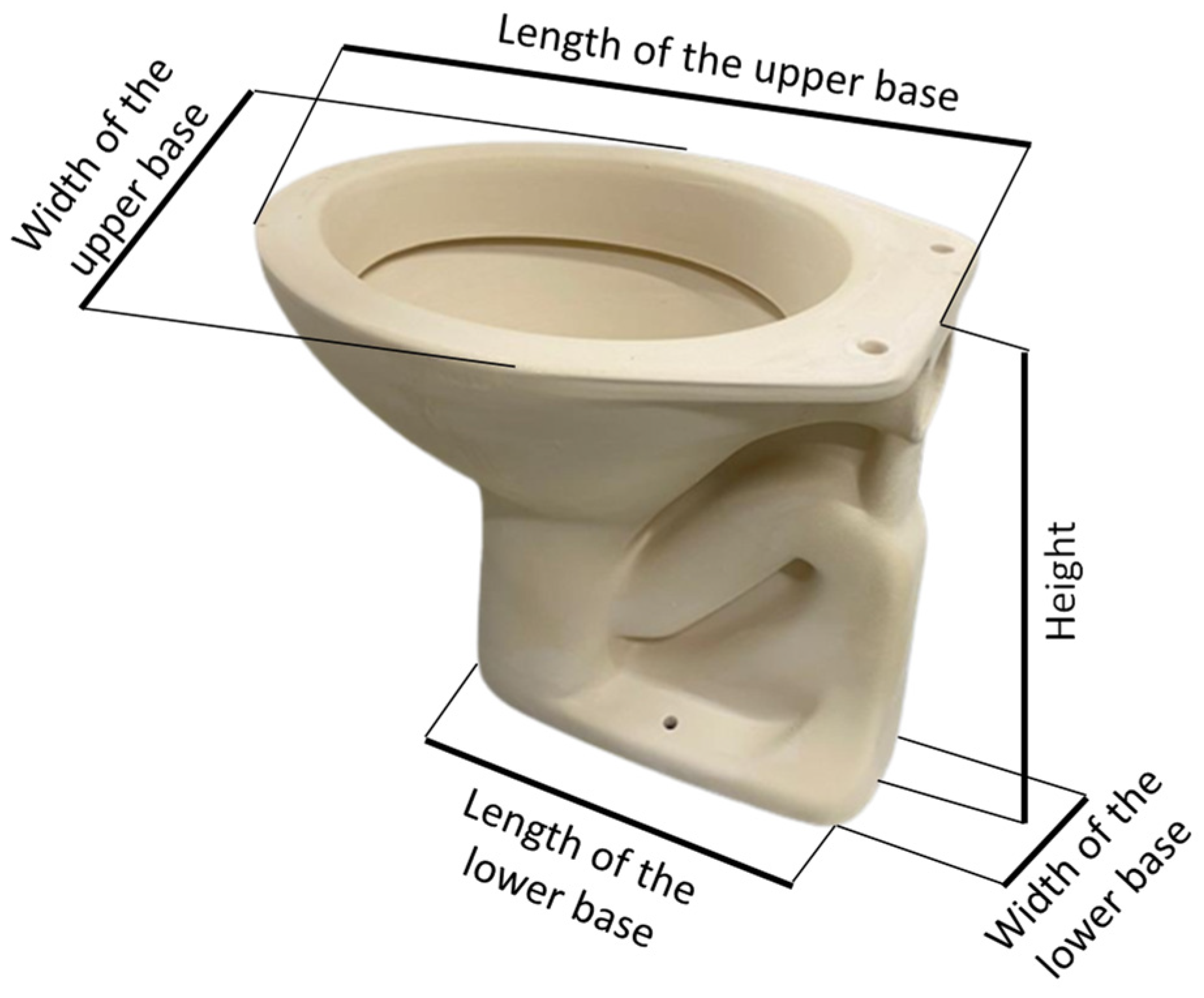
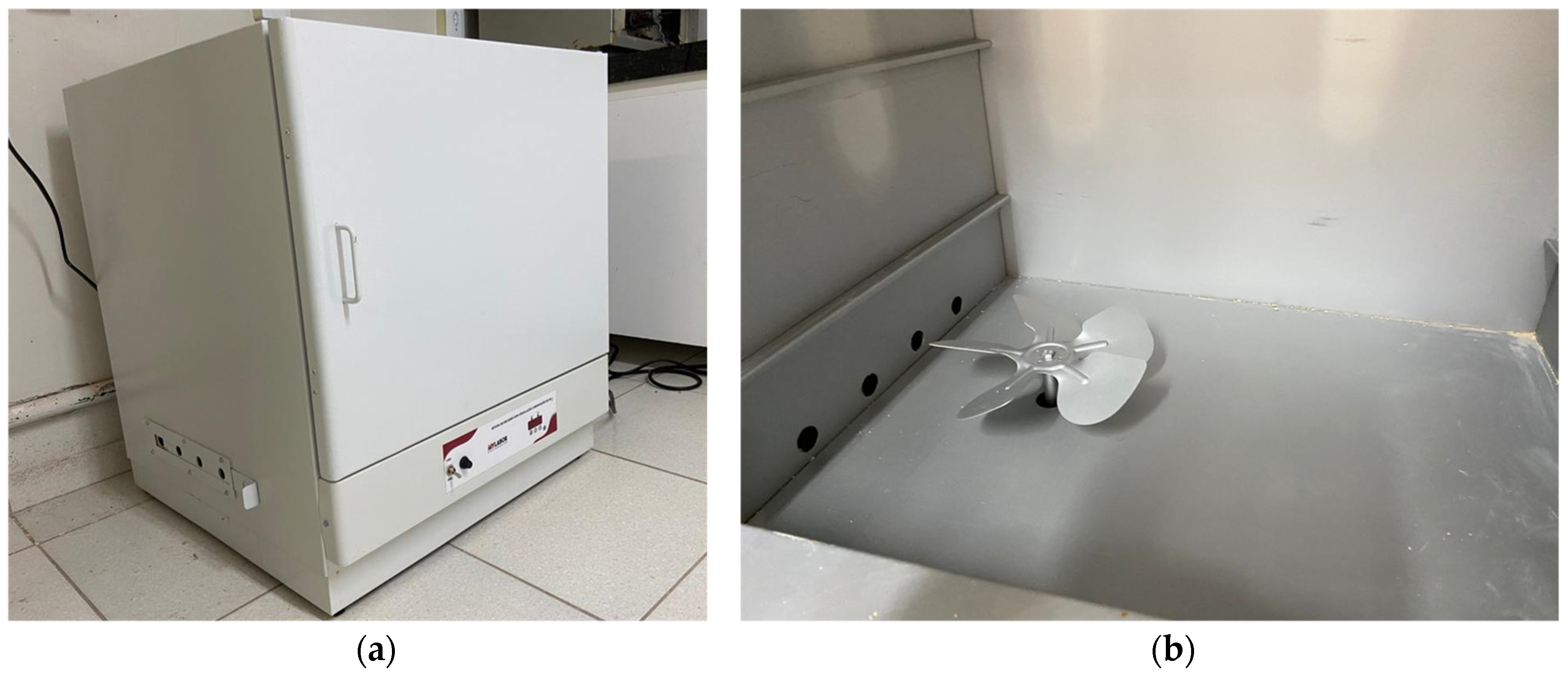
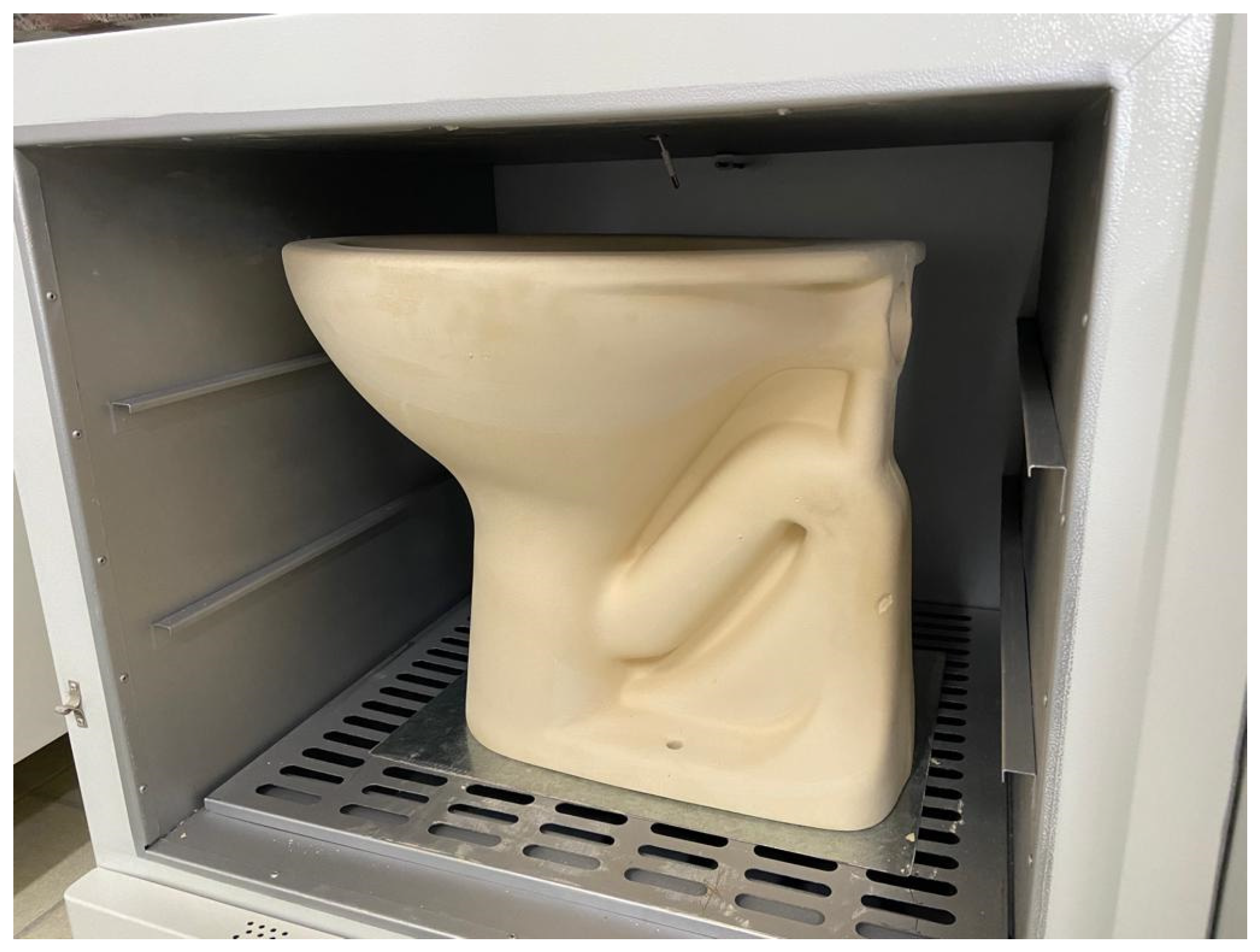
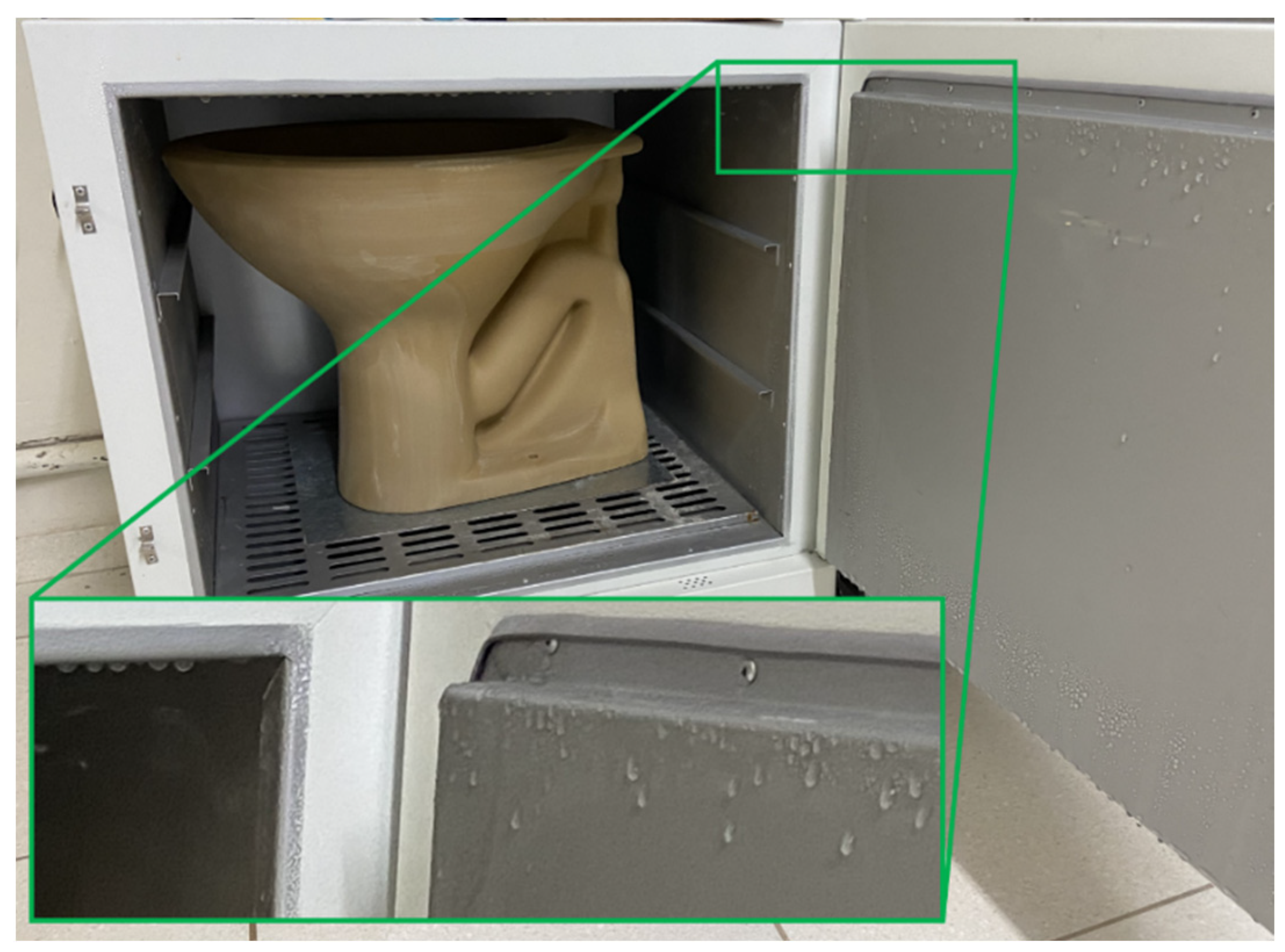
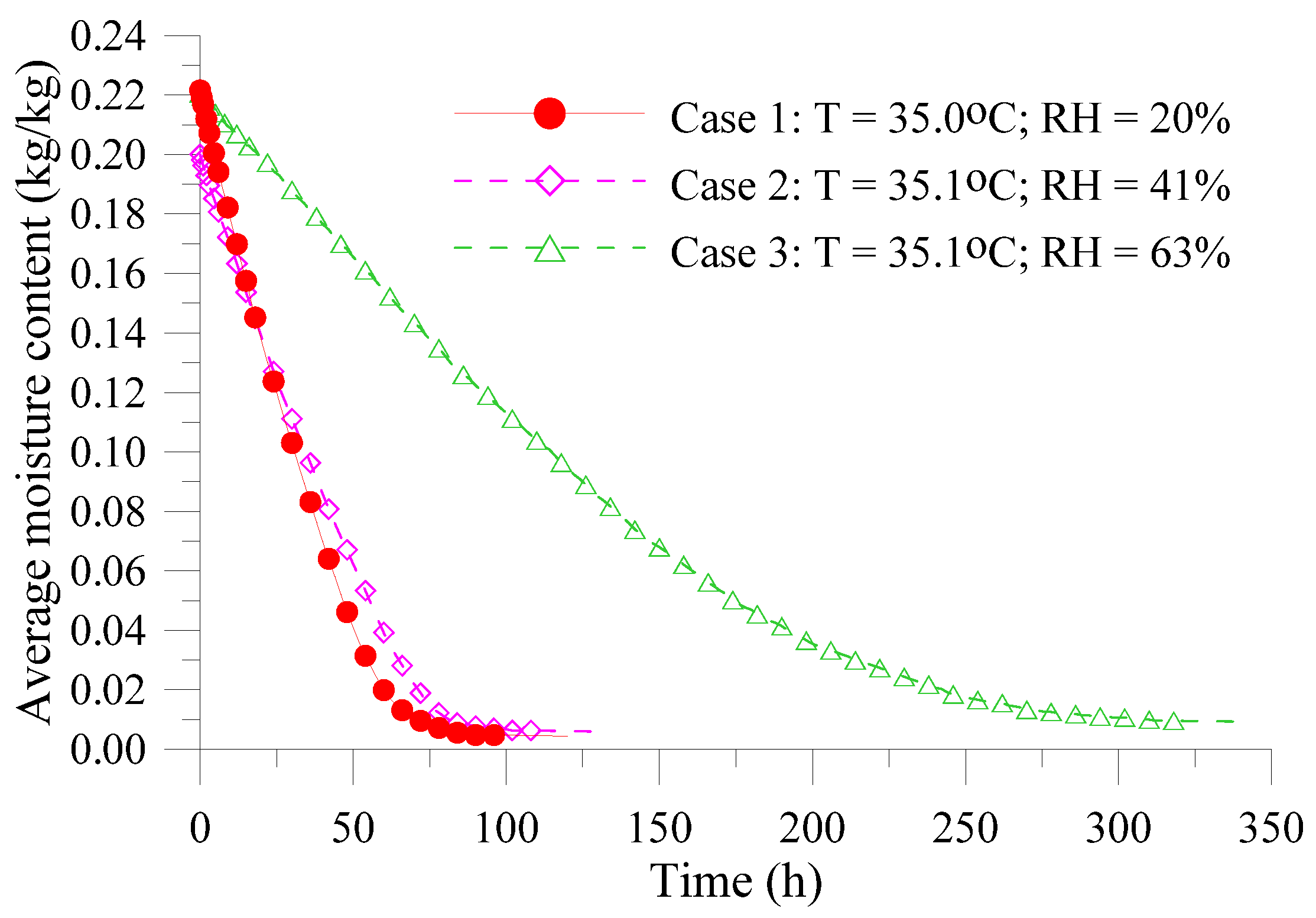

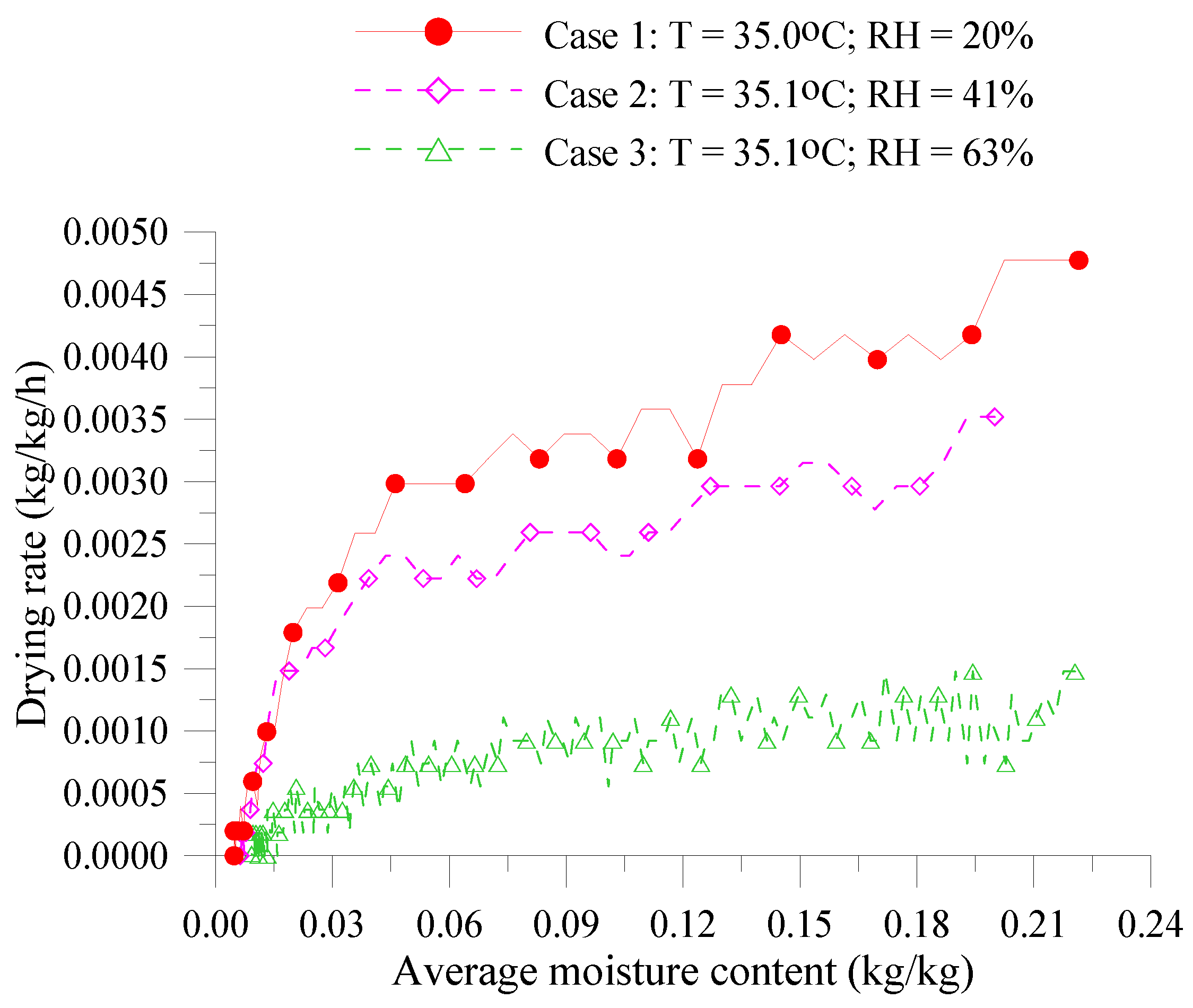
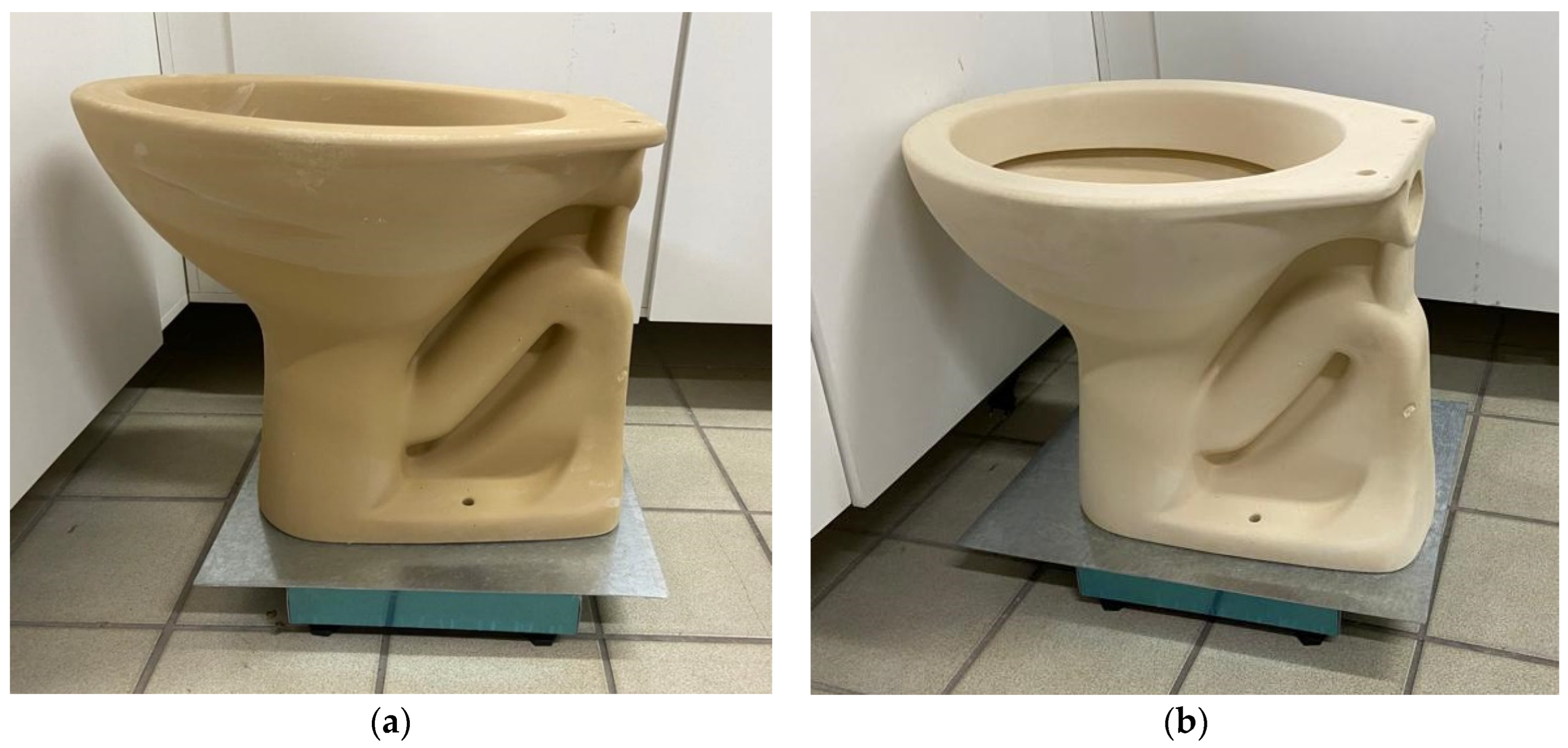

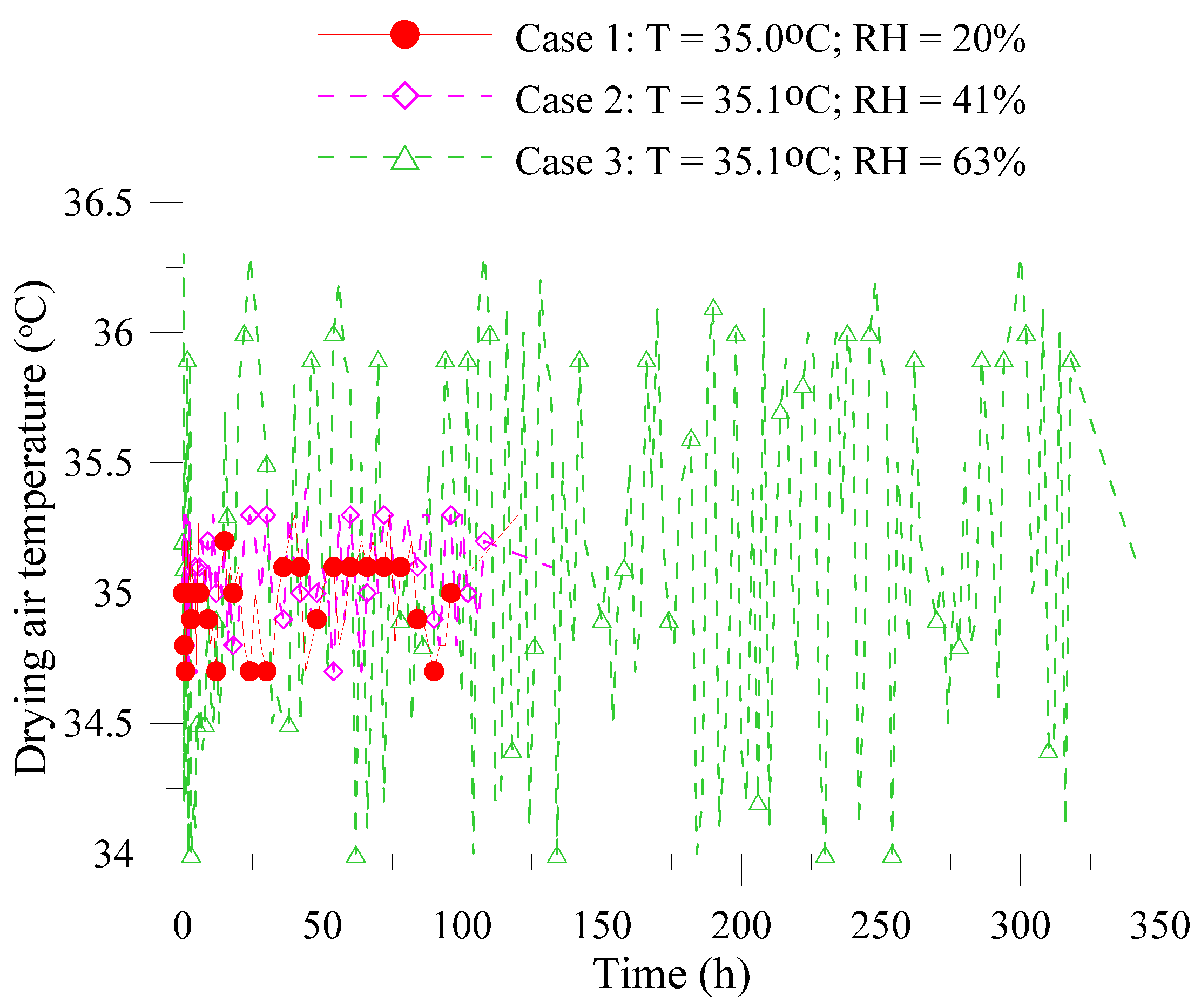

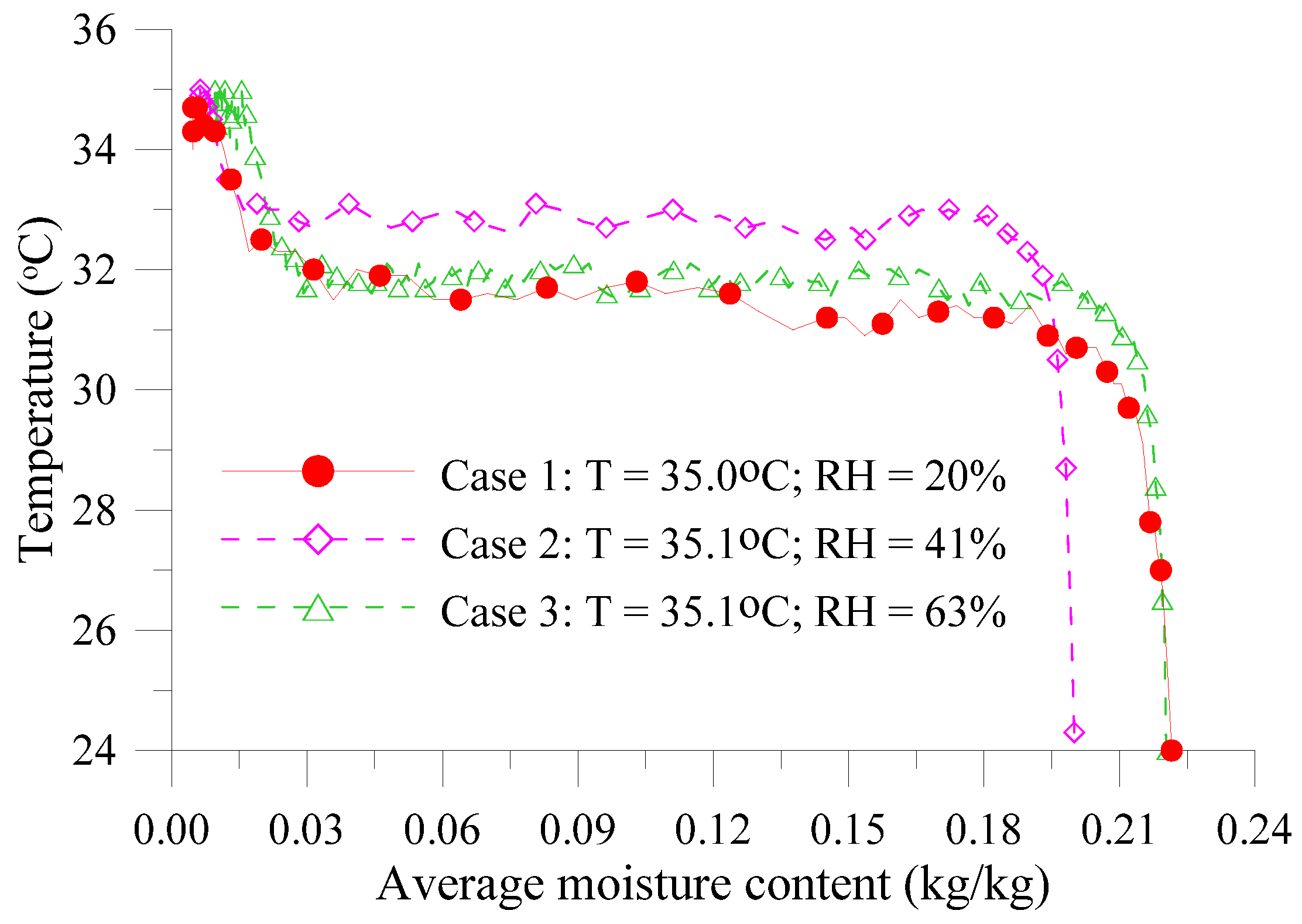
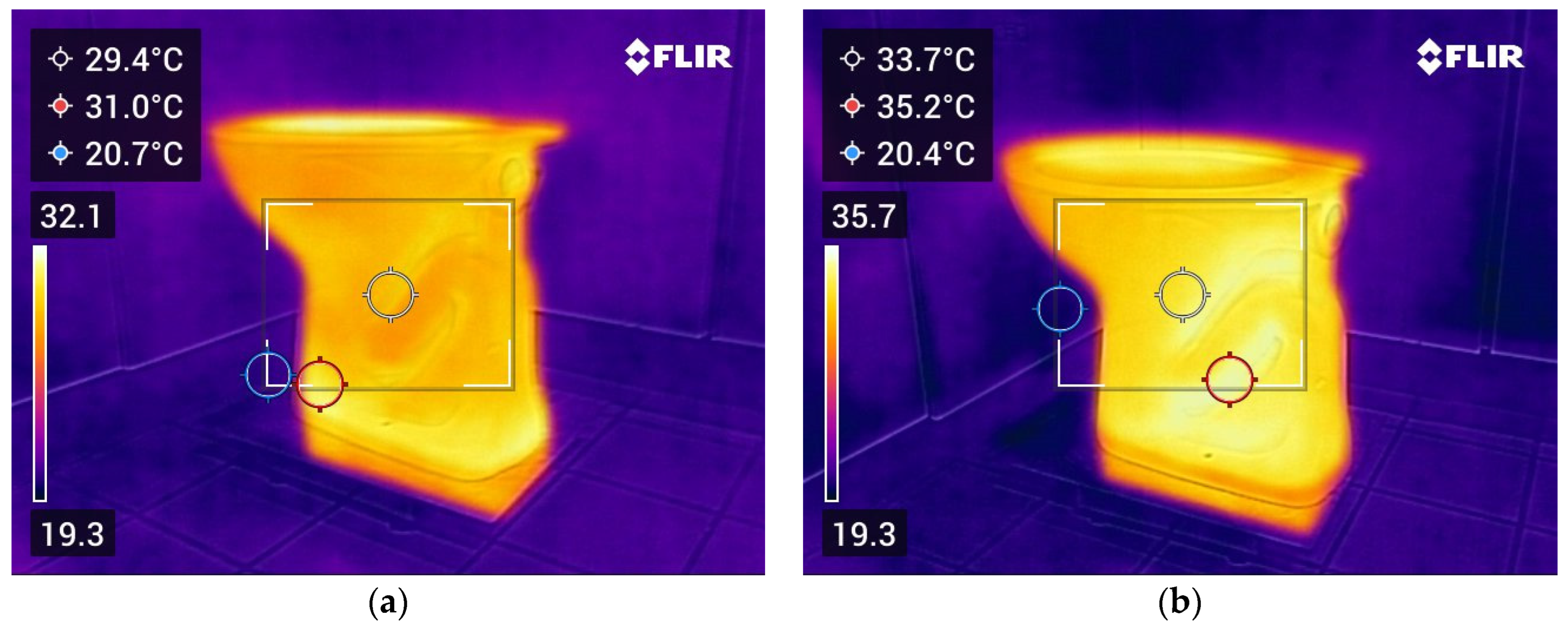


| Case | Local | Type of Ventilation | Drying Air | Sanitary Toilet | |||
|---|---|---|---|---|---|---|---|
| T (°C) | RW (%) | v (m/s) | m0 (g) | T0 (°C) | |||
| 1 | LABFILM | Forced | 35.0 | 20 | 0.1 | 15,355 | 24.0 |
| 2 | TECNOMAT | Forced | 35.1 | 41 | 0.1 | 16,200 | 24.3 |
| 3 | TECNOMAT | Natural | 35.1 | 63 | 0.001 | 16,515 | 24.0 |
| Case | Drying Air | Sanitary Toilet | |||||
|---|---|---|---|---|---|---|---|
| T (°C) | RH (%) | v (m/s) | m0 (g) | mw0 (g) | me (g) | md (g) | |
| 1 | 35.0 | 20 | 0.1 | 15,355 | 2785 | 12,625 | 12,570 |
| 2 | 35.1 | 41 | 0.1 | 16,200 | 2700 | 13,580 | 13,500 |
| 3 | 35.1 | 63 | 0.001 | 16,515 | 2985 | 13,655 | 13,530 |
| Case | M0 (kg/kg, d.b) | Me (kg/kg, d.b) | te (h) | Te (°C) | ΔtM = 0.20→0.15 (h) | ΔtM = 0.20→0.10 (h) | ΔtM = 0.20→0.05 (h) | ΔtM = 0.20→0.01 (h) |
|---|---|---|---|---|---|---|---|---|
| 1 | 0.22156 | 0.00438 | 120 | 34.8 | 12.209 | 26.294 | 42.107 | 66.640 |
| 2 | 0.20000 | 0.00593 | 132 | 35.0 | 16.250 | 34.571 | 55.385 | 81.333 |
| 3 | 0.22062 | 0.00924 | 342 | 35.0 | 44.810 | 95.867 | 155.417 | 288.947 |
| Case | Final Linear Retraction (-) | Final Mass Variation (g) |
|---|---|---|
| 1 | 0.9742 | 2730 |
| 2 | 0.9748 | 2620 |
| 3 | 0.9736 | 2860 |
Disclaimer/Publisher’s Note: The statements, opinions and data contained in all publications are solely those of the individual author(s) and contributor(s) and not of MDPI and/or the editor(s). MDPI and/or the editor(s) disclaim responsibility for any injury to people or property resulting from any ideas, methods, instructions or products referred to in the content. |
© 2023 by the authors. Licensee MDPI, Basel, Switzerland. This article is an open access article distributed under the terms and conditions of the Creative Commons Attribution (CC BY) license (https://creativecommons.org/licenses/by/4.0/).
Share and Cite
Gomez, R.S.; Gomes, K.C.; Gurgel, J.M.; Alves, L.B.; Queiroga, R.A.; Magalhães, H.L.F.; Pinheiro, L.S.S.; Silva, E.J.C.; Oliveira, D.S.; Moreira, H.W.D.; et al. The Effect of Air Relative Humidity on the Drying Process of Sanitary Ware at Low Temperature: An Experimental Study. Processes 2023, 11, 3112. https://doi.org/10.3390/pr11113112
Gomez RS, Gomes KC, Gurgel JM, Alves LB, Queiroga RA, Magalhães HLF, Pinheiro LSS, Silva EJC, Oliveira DS, Moreira HWD, et al. The Effect of Air Relative Humidity on the Drying Process of Sanitary Ware at Low Temperature: An Experimental Study. Processes. 2023; 11(11):3112. https://doi.org/10.3390/pr11113112
Chicago/Turabian StyleGomez, Ricardo S., Kelly C. Gomes, José M. Gurgel, Laís B. Alves, Raissa A. Queiroga, Hortência L. F. Magalhães, Larissa S. S. Pinheiro, Elaine J. C. Silva, Dauany S. Oliveira, Henry W. D. Moreira, and et al. 2023. "The Effect of Air Relative Humidity on the Drying Process of Sanitary Ware at Low Temperature: An Experimental Study" Processes 11, no. 11: 3112. https://doi.org/10.3390/pr11113112
APA StyleGomez, R. S., Gomes, K. C., Gurgel, J. M., Alves, L. B., Queiroga, R. A., Magalhães, H. L. F., Pinheiro, L. S. S., Silva, E. J. C., Oliveira, D. S., Moreira, H. W. D., Brito, H. C., Delgado, J. M. P. Q., & Lima, A. G. B. (2023). The Effect of Air Relative Humidity on the Drying Process of Sanitary Ware at Low Temperature: An Experimental Study. Processes, 11(11), 3112. https://doi.org/10.3390/pr11113112










